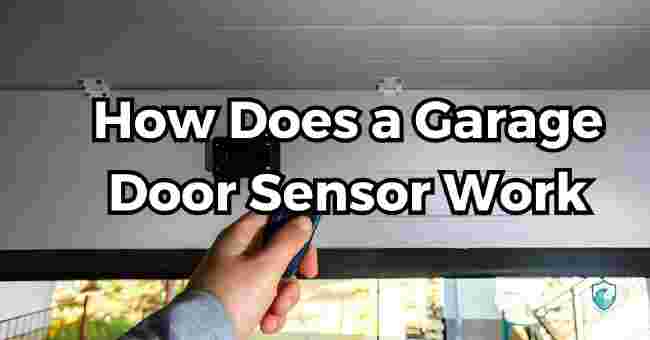Table of Contents
Have you ever wondered how does a garage door sensor work to automatically stop or reverse the heavy door if something obstructs its path?
I definitely had no idea until the day I backed my vintage Mustang out too quickly and heard a horrible crunch.
My heart dropped as I watched in slow motion as the still-descending garage door crumpled my glossy rear fender like a soda can.
After forking out $850 in bodywork, I resolved to decode the magic behind those unassuming little safety devices to prevent any repeats.
What I discovered about the ingenious simplicity of infrared sensors both amazed and embarrassed me.
Whether you’ve smashed up your car or simply puzzled over those plastic brackets, allow me to explain the technology that has saved countless vehicles, personal injuries, and households.
So let’s take an in-depth look at garage door sensor technology and breakdown exactly how these devices manage to pull off their everyday magic.
How Does a Garage Door Sensor Work
Before examining the intricacies of the sensors themselves, it’s important to understand the basics of how garage door openers function.
The average garage door utilizes a trolley system attached to a track along the roof that connects to the entryway.
A mechanical motor pulls the trolley via a chain or drive belt to open and close the door.
Controls for the motorized mechanism are wired to a wall-mounted control panel, which allows the user to operate the device remotely.
This can be done either through a wired button or by radio frequencies from a handheld remote control.
Now, this setup on its own does not provide any inherent safety mechanisms. Automated garage doors have the potential to cause severe injury or damage if something gets caught in their path.
This is where a supplementary sensor system comes into play.
Garage door sensors consist of an infrared or optical transmitter unit on one side of the door and a receiver unit on the opposite side.
These two components continually beam signals back and forth to each other during operation.

The sensor units are strategically positioned so that the signals between them create an invisible beam across the doorway. If something crosses through this field, it disrupts communication between the two parts.
The interruption triggers the safety reversal mechanism to automatically stop and reverse the door’s progress before impact. This happens extremely quickly, within milliseconds!
Let’s break down the sensor operation even further:
- The transmitter portion emits an infrared light beam signal on a specific frequency
- This beam projects out towards the receiver on the opposite side
- The receiver unit “looks” for this exact signal frequency from the matching transmitter
- When the light beam is obstructed, the signal is cut off
- The receiver communication disruption triggers the safety reversal
- An electric signal forces the garage door opener motor to stop and reverse direction
This constant communication feedback loop allows the system to immediately detect objects in the doorway and prevent potential harm.
While the exact specifications may vary across different manufacturers, all modern garage door sensors utilize similar concepts. The brilliance lies in the simplicity of interrupting a wireless signal to activate the safety reversal.
Main Components of Garage Door Sensors
Now that you understand how garage door sensors operate on a basic level, let’s examine the key components and technology that makes these devices tick.
Infrared Photo Eye Sensors
The core mechanism within a garage door sensor is an infrared photo eye. This contains an infrared light emitting diode (LED) and a phototransistor receiver.
- The infrared LED in the transmitter unit emits modulated pulses of infrared light
- The phototransistor in the receiver portion detects these light signals
- Disrupting the steady pulses triggers the safety reversal
These infrared photo eyes offer certain advantages:
- Infrared light is outside the visible color spectrum, so the beams are invisible to the naked eye
- The encased LED components are rugged and durable
- Infrared transmission allows clear signaling even in dusty garage environments
The wavelength of infrared beams used must adhere to FCC regulations regarding wireless transmissions to avoid interference. Most garage door openers operate around 36-40 kHz frequencies.
Transmitter and Receiver Units
The transmitter and receiver make up the two separate components that work together to detect objects obstructing the doorway.
The transmitter houses the infrared LED that shoots out the signal:
- IR LED – Generates the infrared light beam
- Circuit board – Controls LED electrical pulses
- Lens – Focuses and directs the infrared signals
- Housing – Encloses the inner electronics
- Wire connector – Transfers power from main opener
Meanwhile, the matching receiver contains the phototransistor sensor that receives the beam:
- Phototransistor sensor – Detects infrared light signals
- Processing circuitry – Manages electrical outputs
- Lens – Allows infrared beam entry
- Housing – Protects inner sensitive components
- Wire connector – Draws power to sensor
The transmitter and receiver units are designed as a pair to emit and read the same infrared signal patterns. This allows the system to reliably detect when the beam between them loses connection.
Additional Sensor Features
Basic garage door sensors contain just the infrared photo eye technology within the plastic transmitter and receiver housings. However, more advanced units provide additional capabilities:
- Detection field adjustment – Multi-pole switches or dials that allow easy adjustment of the detection field size and range
- Optical alignment aids – LED indicator lights that activate when alignment between the sensors is optimal
- Signal strength indicators – LED light displays to help troubleshoot alignment issues
- Fault diagnostics – Flashing LED codes that display error signals and sensor issues
These enhanced features assist with positioning, calibration, troubleshooting, and maintenance for extended sensor operation.
Proper Positioning Guidelines
The effectiveness of any safety sensors comes down to proper positioning within the garage doorway:
Garage door sensor positioning
To work correctly, the devices must have an unbroken line-of-sight between their lenses. This allows the infrared beams to transmit reliably to trigger the reversal mechanism when disrupted.
The ASME safety standards dictate guidelines for placing garage door sensors to optimize performance:
- Install the sensors 1 to 6 inches off the ground
- Position the sensors so the beam cuts across the door’s pathway when closing
- Angle the sensors slightly downward towards each other
- Separate the sensors no wider than the door width
- Make sure the sensors have at least a 4 inch clearance
- Avoid locations with bright sunlight exposure
Refer to your specific opener manual for further recommendations on positioning. The goal is ensuring proper alignment, operation, and an unobstructed detection zone.
Troubleshooting Sensor Issues
Over years of exposure to dust, vibration, weather elements, and regular use, garage door sensors can experience functionality problems.
But before replacing the whole system, first try identifying and troubleshooting common sensor issues:
| Symptom | Potential Cause | Solution |
|---|---|---|
| Sensors unresponsive / don’t reverse door | Misaligned sensors | Re-align transmitting signal beams between units |
| Safety reversal not triggering | Detection path obstructed | Clear out dirt, debris, cobwebs in the sensor pathway |
| Door reverses but no obstruction | Faulty/malfunctioning sensor | Test & replace damaged sensor unit if needed |
| Sensors have power issues | Low batteries | For battery powered sensors, replace with fresh batteries |
| Sensors unresponsive | Damaged/disconnected wiring | Inspect sensor wires for fraying, cuts, loose connections |
| Symptom | Potential Cause | Solution |
|---|---|---|
| Sensors don’t activate | Improper alignment | Recalibrate beam signal path between sensors |
| No LED indicator lights | Blown fuse | Check wiring system fuses and replace any broken fuses |
| Sensors activate randomly | Radio signal interference | Identify nearby devices causing signal conflict |
| Safety reversal mid-door travel | Binding door | Check for door track alignment or clogged tracks |
In many cases, sensor functionality issues come down to alignment disruption, interference, damage, or straightforward power and wiring problems.
Before replacing the entire system, see if realigning, cleaning, or testing the existing hardware can restore proper operation.
Refer to your garage door opener owner’s manual for further sensor troubleshooting advice.
Technical support teams can also help diagnose issues over the phone or by video chat apps.
Don’t immediately assume the worst with finicky sensors. Nine times out of ten, the problem stems from something simple that doesn’t require replacing the entire rig.
Performing Routine Sensor Maintenance
To avoid headaches down the road, perform regular maintenance checks on your garage door safety sensor system. This prevents small issues from ballooning into serious safety hazards.
Follow this quick maintenance routine at least once a year:
- Carefully wipe down sensor lenses with a microfiber cloth to remove dust and grime
- Check for cobwebs, plant encroachment or other obstructions in the beam path way
- Ensure the transmitter and receiver LED indicator lights activate when powered on
- Test that the safety reversal mechanism triggers when breaking the sensor beam with an object
- Verify all wiring connections remain securely attached with no fraying or corrosion
- Replace batteries in battery-powered sensors to maintain optimal power
- Subtly adjust alignment if needed to maintain proper functionality
Taking just 10-15 minutes to proactively maintain your sensors can identify problems before they spin out of control.
Review your owner’s manual for the recommended upkeep schedule from the manufacturer.
Upgrading to New Sensor Systems
As garage door opener technology continues advancing, newer sensor models provide cutting-edge safety capabilities.
If your system seems outdated or flawed, an upgrade might be in order.
Some benefits of newer photo eye sensor designs include:
- Wireless connectivity removes messy wiring systems
- Multi-frequency anti-interference avoids radio conflicts
- Enhanced alignment and troubleshooting assistance features
- Cryptographic security protocols prevent hacking
- Sleek, compact housing profiles for minimal footprint
Retrofitting newer external sensors onto old openers is not advisable though, as compatibility issues often arise.
For optimal functionality and safety assurance, it is best to replace the entire opener and sensor rig.
Given the importance of garage door safety, the cost to upgrade pales in comparison to medical bills or property damage from malfunctioning systems.
Check in with a trained garage door technician to discuss replacement options tailored to your needs if the current setup seems questionable.
Garage Door Sensor FAQs
For quick answers to some of the most common questions about photo eye sensors, check out this handy FAQ:
What If My Sensor Has An Error Code?
- Refer to your owner’s manual for the diagnostic meaning behind any flashing LED error signals. This helps identify specific issues.
Why Does My Sensor Randomly Go Off?
- Nearby radio signal interference can disrupt the sensor frequency causing random triggering. Identify sources of conflict like ham radios or bugs zappers to resolve this.
How Do I Align Garage Door Sensors?
- Small alignment adjustments can make sure the infrared transmitter and receiver maintain line-of-sight communication. Refer to your owner’s manual for step-by-step realignment methods.
Do Sensors Require Wiring?
- Hard-wired sensors connect via wiring back to the opener unit for power. Battery powered options provide wire-free installation but require periodic battery replacement.
Can Weather Damage Sensors?
- Exposure to humidity, storms, temperature extremes over time can potentially harm sensor internals if the housing seal is compromised.
How Long Should Sensors Last?
- General lifespan under normal operation ranges from 5-10 years. Higher end models with robust construction can function reliably for over 15 years.
Conclusion:- Remembering the Magic of Garage Door Sensors
As we covered, seemingly basic garage door sensors harness infrared photoelectric beams to automatically command the opener to halt or reverse when objects cross their signals.
Memorizing key proper sensor placement guidelines, troubleshooting common functionality issues, performing routine checkups, and upgrading outdated systems are key for safely operating garage access points over their lifespan.
After learning what triggers the all-important safety reversal mechanism, hopefully you’ll never take those small but mighty sensors for granted again.
Going forward, I know I’ll cherish garage door sensors as miniature guardians protecting far more than just my rear fender.




